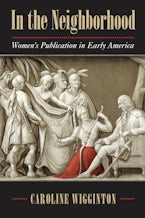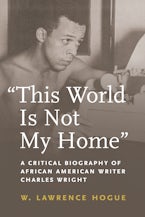- Home
- In the Neighborhood

In the Neighborhood
Women's Publication in Early America
Published by: University of Massachusetts Press
240 Pages, 6.00 x 9.00 x 0.70 in, 9 color illus., 11 b&w illus.
Other Retailers:
Winner of the 2018 Early American Literature Book Prize
In this compelling and original book, Caroline Wigginton reshapes our understanding of early American literary history. Overturning long-standing connections between the male-dominated print culture of pamphlets, broadsides, and newspapers and the transformative ideas that instigated the American Revolution, Wigginton explores how women's "relational publications"—circulated texts, objects, and performances—transformed their public and intimate worlds. She argues that Native, black, and white women's interpersonal "publications" revolutionized the dynamics of power and connection in public and private spaces, whether those spaces were Quaker meeting houses, Creek talwas, trading posts, burial grounds, or the women's own "neighborhoods."
Informed by deep and rich archival research, Wigginton's case studies explore specific instances of "relational publication." The book begins with a pairing of examples—the statement a grieving Lenape mother made through a wampum belt and the political affiliations created when a salon hostess shared her poetry. Subsequent chapters trace a history of women's publication practice, including a Creek woman's diplomatic and legal procession-spectacles in the colonial Southeast, a black mother's expression of protest in Newport, Rhode Island, and the resulting evangelical revival, Phillis Wheatley's elegies that refigured neighborhoods of enslaved and free Bostonians, and a Quaker woman's pious and political commonplace book in Revolutionary Philadelphia.
In this compelling and original book, Caroline Wigginton reshapes our understanding of early American literary history. Overturning long-standing connections between the male-dominated print culture of pamphlets, broadsides, and newspapers and the transformative ideas that instigated the American Revolution, Wigginton explores how women's "relational publications"—circulated texts, objects, and performances—transformed their public and intimate worlds. She argues that Native, black, and white women's interpersonal "publications" revolutionized the dynamics of power and connection in public and private spaces, whether those spaces were Quaker meeting houses, Creek talwas, trading posts, burial grounds, or the women's own "neighborhoods."
Informed by deep and rich archival research, Wigginton's case studies explore specific instances of "relational publication." The book begins with a pairing of examples—the statement a grieving Lenape mother made through a wampum belt and the political affiliations created when a salon hostess shared her poetry. Subsequent chapters trace a history of women's publication practice, including a Creek woman's diplomatic and legal procession-spectacles in the colonial Southeast, a black mother's expression of protest in Newport, Rhode Island, and the resulting evangelical revival, Phillis Wheatley's elegies that refigured neighborhoods of enslaved and free Bostonians, and a Quaker woman's pious and political commonplace book in Revolutionary Philadelphia.
Caroline Wigginton is assistant professor of English at the University of Mississippi.
"With its focus on 'relational publications,' the book challenges standard accounts of eighteenth-century print culture, according to which men engaged with print to build the new nation and shape the publics that became a key space for defining identity."—Kelly Wisecup, author of Medical Encounters: Knowledge and Identity in Early American Literatures (University of Massachusetts Press, 2013)
"A compelling work of scholarship, In the Neighborhood stands to make a substantial, lasting contribution to early American literature and to all the conversations in which it is engaged, from Native American history to African American poetry, to political diplomacy, religious expression, and autobiographical writing in early America."—Lisa Brooks, author of The Common Pot: The Recovery of Native Space in the Northeast
"Wigginton offers an insightful, overdue corrective to 'masculinist' histories of republican print culture and the public sphere. Complicating distinctions between gendered 'public' and 'private' realms, the author suggests the importance of women's interpersonal intimacy as a rhetorical and political alternative to the anonymity and abstraction that characterized 18th-century print media and the public sphere. Highly recommended."—Choice Reviews
"Wigginton's overall notion of women's relational writing and publication as a neighborhood protest against the coercive pressure of nationhood and republican print is important and provocative. So is her somewhat surprising survey of literary works at her study's end."—Early American Literature
"Revising older arguments about the importance of print publication in the colonial and early national public sphere, Wigginton posits a model of shared words and performances through relationships and exchanges in geographic and virtual spaces. . . . The ramifications of this model for women's expressions are far-reaching."—Legacy: Journal of American Women Writers
"Smoothly written and forcefully argued, In the Neighborhood invites reconsideration of numerous forms of cultural production beyond the printed page."—Textual Cultures
Winner of the 2018 Early American Literature Book Prize











